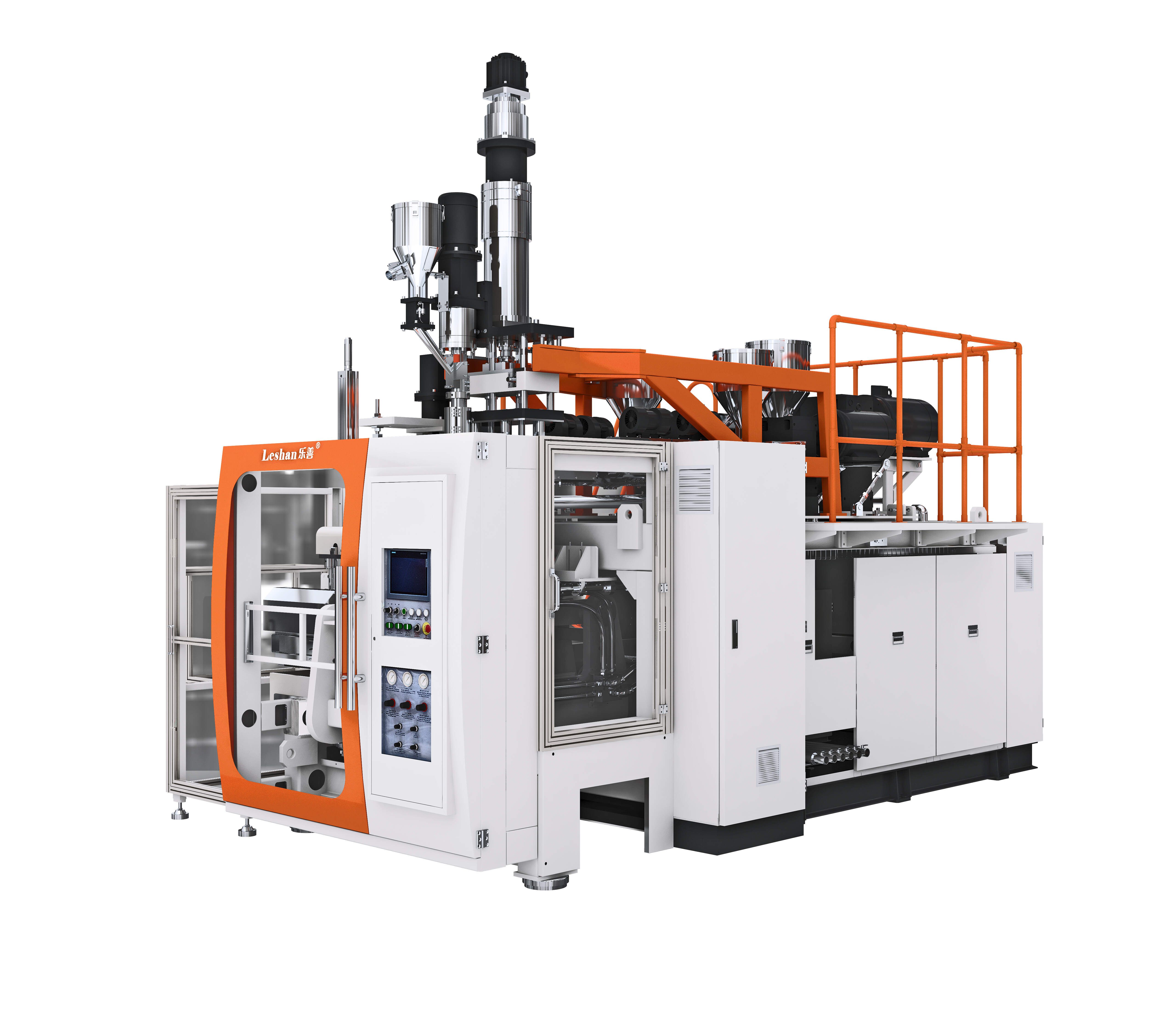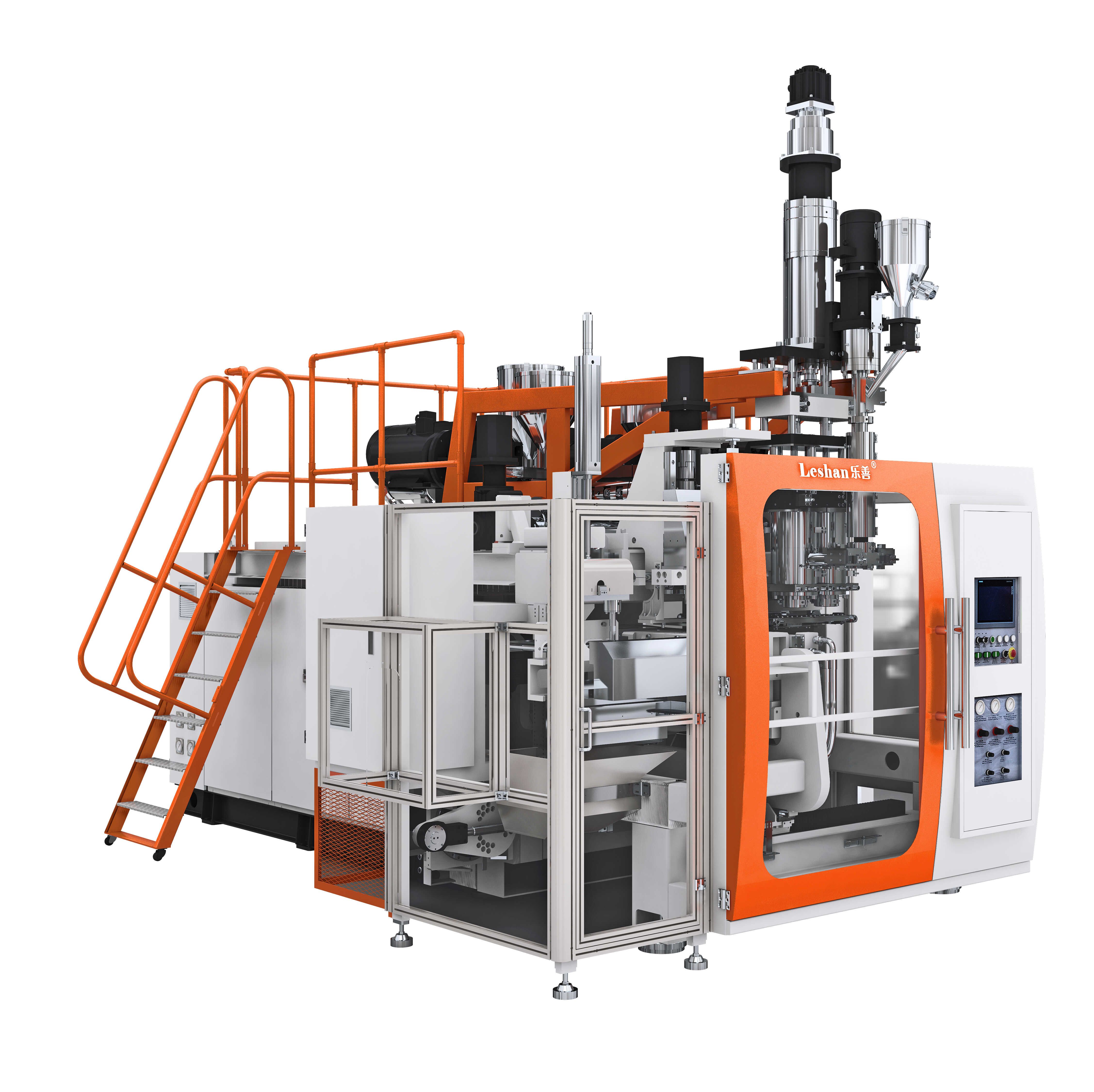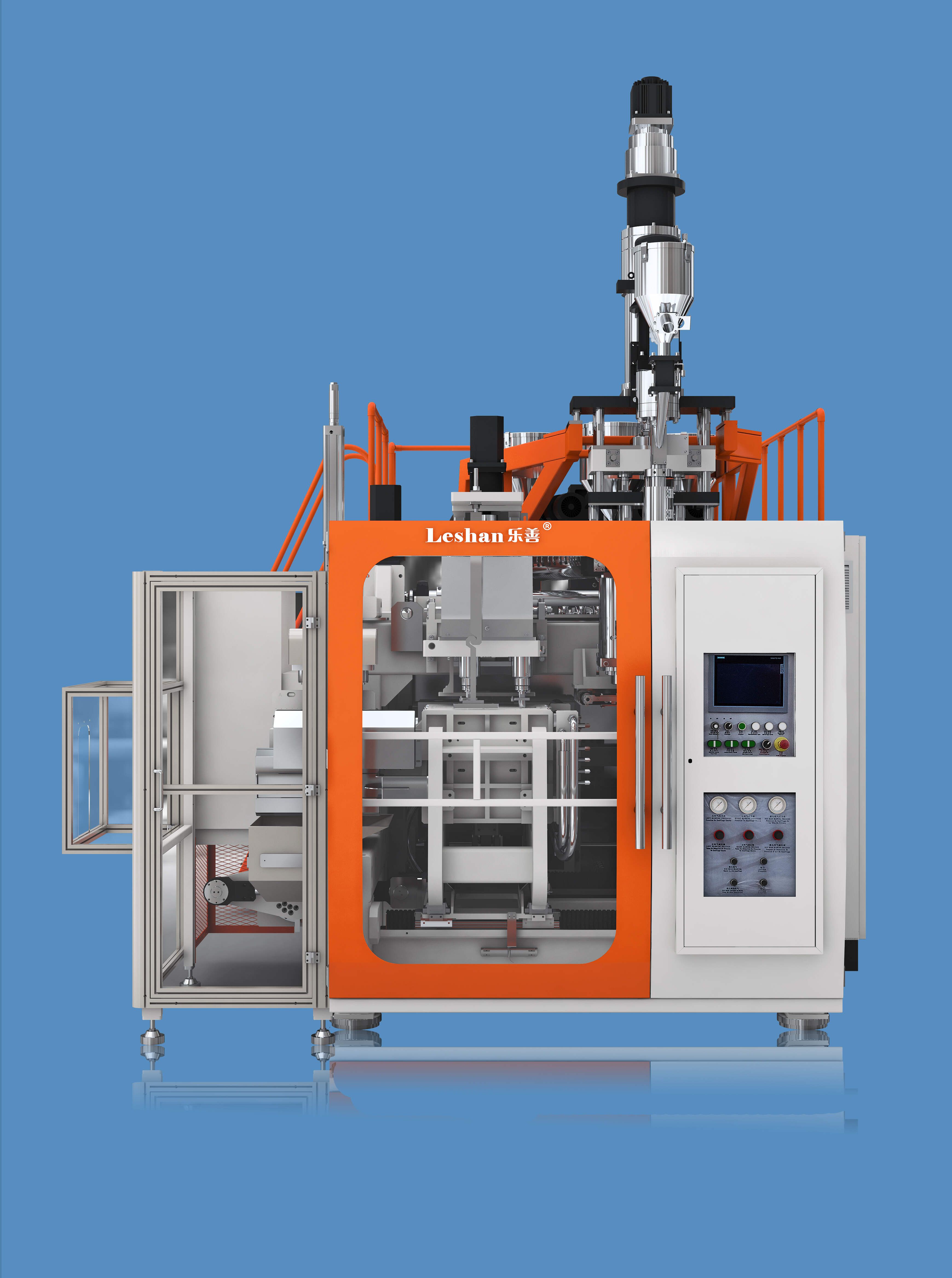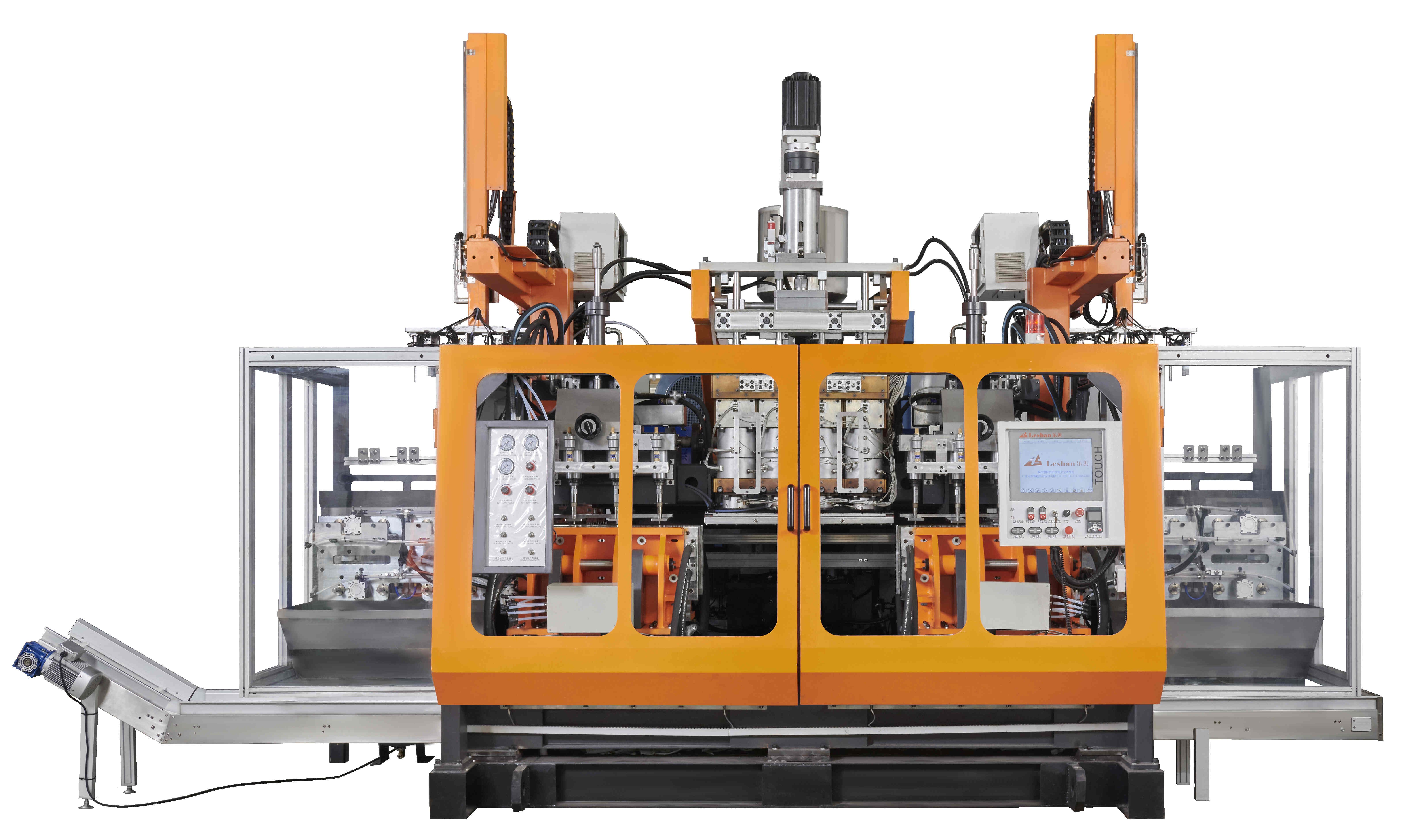
20l extrusion blow molding machine
20l extrusion blow molding machine
Leshan Intelligent Equipment Corp.,Ltd specializes in the research and development, design, and manufacturing of plastic machinery. Over the past 20 years, we have always devoted our energy to new fields of plastic machinery, constantly updating our technology and learning advanced experience. Nowadays, we produce equipment such as Blowing Mould & Injection Mould,Auxiliary machine,Daily chemistry bottle blow molding machine,Engine oil bottle blow molding machine,Chemical barrel blow molding machine,Extrusion Die Head,Food bottle blow molding machine,Milk bottle blow molding machine,multi-layer coextrusion blow molding machine,Irregular shape product blow molding machine,Cleaning bottle blow molding machine.
Currently, Leshan has professional equipment such as Four axis CNC machining-center,Numerical-controlled knee bend machine,Pentahedron gantry machining center,Vertical CNC gantry machining-center. And it has strong comprehensive strength in research and development, production and marketing, and technical support. We warmly export our machines to countries and regions such as the United States, Russia, Poland, and United Kingdom,Nepal,Saudi Arabia,Suriname. We also provide the fastest response and solution to customer issues and requirements.
| Parameter | Information |
| Product Name | 20l extrusion blow molding machine |
| Brand Name | Leshan |
| Place of Origin | Foshan,China |
| PLC Brand | Siemens |
| Core Components | Gear,Pump,Pressure vessel,Engine,Gearbox,Bearing...etc |
| Warranty | 1year |
| Plastic Processed | PVC,PA,Polystyrene,ABS,PC,EVA,PP...etc |
| Application | Bottle |
| Port | ShunDe/GuangZhou/ShenZhen China |
| MOQ | 1 Set |
| Export Country | Russia, Australia, Poland,Congo, Democratic Republic of the,Central African Republic,Nicaragua...etc |
| Export region | Europe,Oceania,America... |
| Certification | ISO 9001,CE...etc |
| Automatic | Yes |
| Screw L/D Ratio | 24 |
| Packaging Details | Standard exporting machine packing with plastic film |
| Color | Customized |
| Accumulator Capacity(L) | 100 L |
| Service | Free spare parts... |
| Supply Ability | 500 Set/Sets per Month |
| Lead time (days) | 70 (To be negotiated) |
Please note: The above table data is for reference only. For specific information, please contact us.

With the development of science and technology, 20l extrusion blow molding machine have become intelligent and automated. Through the advanced control system, accurate control of various parameters, such as temperature, pressure, time, etc., can be achieved. Precise control of these parameters can ensure the stable quality of products and reduce losses during the production process.

20l extrusion blow molding machine---FAQs Guide
2.What are the general raw materials for 20l extrusion blow molding machine?
3.How to prevent air leakage in 20l extrusion blow molding machine?
4.How to design the shaping mold for 20l extrusion blow molding machine?
5.What is the cost composition of 20l extrusion blow molding machine?
6.How to solve the malfunction of the 20l extrusion blow molding machine?
7.How does the extrusion blow molding process differ from injection blow molding, and what types of products are typically produced using each method?
8.What is the operating cost of a 20l extrusion blow molding machine?
9.What are the advantages of Leshan blow molding machine?
10.How long is the production cycle of Leshan blow molding machine? What is the lead time?
11.Which industries can apply 20l extrusion blow molding machine?
1.What is the difference between traditional 20l extrusion blow molding machine and fully computer-controlled blow molding machines?
We have the leading technology and innovation capabilities, and attach importance to employee training and development, and provide promotion opportunities.
Traditional blow molding machines are operated manually by a person, while fully computer-controlled blow molding machines are operated by a computer program. This means that traditional blow molding machines require more human labor and supervision, while fully computer-controlled machines can run automatically with minimal human intervention.
Additionally, traditional blow molding machines may have limited capabilities and may only be able to produce simple shapes, while fully computer-controlled machines can produce more complex and precise shapes. This is because the computer program can control the machine's movements and parameters with greater accuracy and consistency.
Furthermore, fully computer-controlled blow molding machines often have advanced features such as real-time monitoring, data collection, and automatic adjustments, which can improve efficiency and quality control.
Overall, the main difference between traditional blow molding machines and fully computer-controlled machines is the level of automation and precision in the production process.
2.What are the general raw materials for 20l extrusion blow molding machine?
We pay attention to employee development and benefits, and provide a good working environment in order to improve the efficiency of employees and improve the quality management of 20l extrusion blow molding machine products.
1. Plastic Resin: The most common raw material used in blow molding machines is plastic resin, which is melted and formed into a hollow tube to create the desired shape.
2. Colorants: Colorants are added to the plastic resin to give the final product its desired color.
3. Additives: Additives such as UV stabilizers, antioxidants, and flame retardants may be added to the plastic resin to improve the properties of the final product.
4. Compressed Air: Compressed air is used to inflate the plastic tube and shape it against the mold.
5. Mold Release Agents: Mold release agents are used to prevent the plastic from sticking to the mold during the molding process.
6. Lubricants: Lubricants are used to reduce friction between the plastic and the mold, making it easier to remove the final product.
7. Cooling Water: Cooling water is used to cool the plastic and solidify it into the desired shape.
8. Mold Inserts: Mold inserts are used to create specific features or details on the final product.
9. Labels and Packaging Materials: Labels and packaging materials may be added to the final product after it has been molded.
10. Recycled Materials: Some blow molding machines may also use recycled plastic materials as a raw material, reducing waste and promoting sustainability.
3.How to prevent air leakage in 20l extrusion blow molding machine?
We should perform well in market competition, and the prices of 20l extrusion blow molding machine products have a great competitive advantage.
1. Regular Maintenance: Regular maintenance of the blow molding machine is essential to prevent air leakage. This includes checking and replacing worn out seals, gaskets, and other components that may contribute to air leakage.
2. Proper Lubrication: Lubrication of moving parts is important to ensure smooth operation of the machine and prevent air leakage. Make sure to use the recommended lubricants and follow the manufacturer's instructions for lubrication intervals.
3. Check Air Hoses and Fittings: Inspect the air hoses and fittings for any cracks, tears, or loose connections. Replace any damaged parts immediately to prevent air leakage.
4. Use High-Quality Components: Using high-quality components, such as valves, seals, and gaskets, can help prevent air leakage in the blow molding machine. These components are designed to withstand high pressures and are less likely to fail.
5. Adjust Air Pressure: Make sure to adjust the air pressure according to the manufacturer's recommendations. Too much or too little air pressure can cause air leakage in the machine.
6. Properly Align Parts: Misaligned parts can cause air leakage in the blow molding machine. Make sure all parts are properly aligned and tightened to prevent air from escaping.
7. Regularly Inspect the Machine: Regularly inspect the machine for any signs of air leakage, such as hissing sounds or drops in air pressure. If any issues are found, address them immediately to prevent further air leakage.
8. Train Operators: Properly trained operators can help prevent air leakage by operating the machine correctly and identifying any potential issues before they become major problems.
9. Use Air Leak Detection Systems: Consider using air leak detection systems to identify and locate any air leaks in the machine. This can help prevent air leakage and improve the overall efficiency of the machine.
10. Replace Worn Out Parts: Over time, parts of the blow molding machine may wear out and contribute to air leakage. It is important to regularly replace these parts to maintain the integrity of the machine and prevent air leakage.

4.How to design the shaping mold for 20l extrusion blow molding machine?
We continuously upgrade our skills and knowledge to adapt to changing 20l extrusion blow molding machine market needs.
1. Determine the shape and size of the final product: The first step in designing a shaping mold for blow molding machines is to determine the shape and size of the final product. This will help in determining the overall dimensions and features of the mold.
2. Choose the type of blow molding machine: There are different types of blow molding machines such as extrusion blow molding, injection blow molding, and stretch blow molding. Each type requires a different type of mold design, so it is important to choose the right type of machine for your product.
3. Create a 3D model of the product: Using CAD software, create a 3D model of the product to be molded. This will help in visualizing the final product and identifying any potential design issues.
4. Determine the number of cavities: The number of cavities in the mold will depend on the production volume and the size of the product. More cavities will increase the production rate, but it will also increase the complexity and cost of the mold.
5. Design the core and cavity: The core and cavity are the two main components of the mold. The core is the inner part of the mold that shapes the product, while the cavity is the outer part that gives the product its final shape. The design of these components should be precise and accurate to ensure a high-quality product.
6. Consider draft angles: Draft angles are important in blow molding as they allow the product to be easily removed from the mold. A draft angle of 3-5 degrees is recommended for most products.
7. Add cooling channels: Cooling channels are essential for maintaining the temperature of the mold during the molding process. These channels should be strategically placed to ensure uniform cooling and prevent warping of the product.
8. Include ejection system: An ejection system is used to remove the product from the mold after it has been formed. This can be in the form of pins, air blasts, or mechanical ejection systems.
9. Test and refine the design: Once the initial design is complete, it is important to test it on a prototype mold to identify any design flaws or issues. This will help in refining the design before the final mold is produced.
10. Consider material selection: The material used for the mold should be able to withstand high temperatures and pressures. Common materials used for blow molding molds include aluminum, steel, and beryllium copper.
11. Work with a professional mold maker: It is recommended to work with a professional mold maker who has experience in designing molds for blow molding machines. They can provide valuable insights and ensure that the mold is designed to meet your specific requirements.
5.What is the cost composition of 20l extrusion blow molding machine?
We focus on providing high 20l extrusion blow molding machine quality products and services.
The cost composition of blow molding machines can vary depending on the type and size of the machine, as well as the manufacturer and country of origin. However, the general cost composition can be broken down into the following components:
1. Machine base: This includes the main frame, base plate, and other structural components of the machine. It typically accounts for 20-30% of the total cost.
2. Extruder: The extruder is the heart of the blow molding machine and is responsible for melting and shaping the plastic material. It can account for 30-40% of the total cost.
3. Molds: Molds are used to shape the plastic material into the desired product. The cost of molds can vary greatly depending on the complexity and size of the product being produced. It can account for 20-30% of the total cost.
4. Control system: The control system includes the electrical and electronic components that control the operation of the machine. It can account for 10-15% of the total cost.
5. Hydraulic system: The hydraulic system is responsible for providing the necessary pressure and power to operate the machine. It can account for 5-10% of the total cost.
6. Other components: Other components such as motors, pumps, valves, and sensors can also contribute to the overall cost of the machine.
In addition to these components, the cost of blow molding machines may also include expenses such as labor, transportation, and installation. It is important to note that the cost composition may vary depending on the specific features and capabilities of the machine.
6.How to solve the malfunction of the 20l extrusion blow molding machine?
As one of the top 20l extrusion blow molding machine manufacturers in China, we take this very seriously.
1. Check the power supply: Make sure the machine is properly connected to a stable power source. If there is a power surge or fluctuation, it can cause the machine to malfunction.
2. Inspect the air supply: The blow molding machine requires a steady supply of compressed air to function properly. Check the air compressor and make sure it is providing enough pressure and volume.
3. Check the temperature settings: The temperature of the machine's heating elements must be set correctly for the plastic to melt and form properly. Make sure the temperature settings are appropriate for the type of plastic being used.
4. Clean and lubricate the machine: Over time, dust, debris, and residue can build up on the machine, causing it to malfunction. Clean and lubricate all moving parts to ensure smooth operation.
5. Check for worn or damaged parts: Inspect all parts of the machine for wear and tear. Replace any damaged or worn parts to prevent further malfunctions.
6. Adjust the mold: If the product being produced is not forming correctly, the mold may need to be adjusted. Make sure the mold is properly aligned and tightened.
7. Consult the manual: If the above steps do not solve the problem, consult the machine's manual for troubleshooting tips and solutions specific to your machine.
8. Call a professional: If the problem persists, it may be best to call a professional technician to diagnose and repair the machine. Attempting to fix complex issues without proper knowledge and training can cause further damage.

7.How does the extrusion blow molding process differ from injection blow molding, and what types of products are typically produced using each method?
We have been working hard to improve service quality and meet customer needs.
Extrusion blow molding and injection blow molding are two different processes used to manufacture plastic products. While both methods involve melting plastic and shaping it into a desired form, there are some key differences between the two.
Extrusion blow molding is a process in which a molten tube of plastic, called a parison, is extruded through a die and then inflated to form a hollow product. The parison is then cooled and the mold opens to release the finished product. This process is commonly used to produce bottles, containers, and other hollow objects.
On the other hand, injection blow molding involves injecting molten plastic into a mold cavity, where it is then cooled and solidified. The mold then opens to release the finished product. This process is commonly used to produce small, complex, and precise products such as medical devices, pharmaceutical packaging, and small bottles.
One of the main differences between the two processes is the way the plastic is shaped. In extrusion blow molding, the plastic is shaped by the inflation of the parison, while in injection blow molding, the plastic is shaped by the mold cavity.
Another difference is the type of molds used. In extrusion blow molding, the molds are typically made of two halves that come together to form the desired shape. In injection blow molding, the molds are usually made of a single piece that is opened and closed to release the product.
The type of plastic used also differs between the two processes. Extrusion blow molding is typically used for high-density polyethylene (HDPE) and polyethylene terephthalate (PET) plastics, while injection blow molding is commonly used for polypropylene (PP) and polyethylene (PE) plastics.
In terms of product applications, extrusion blow molding is commonly used for larger, more simple products such as bottles and containers, while injection blow molding is used for smaller, more complex products such as medical devices and pharmaceutical packaging.
In summary, extrusion blow molding and injection blow molding are two different processes used to manufacture plastic products. While both methods involve melting plastic and shaping it into a desired form, they differ in the way the plastic is shaped, the type of molds used, and the types of products produced.
8.What is the operating cost of a 20l extrusion blow molding machine?
We attach importance to the innovation ability and team spirit of employees, have advanced R & D facilities and laboratories, and have a good quality management system.
The operating cost of a blow molding machine can vary depending on factors such as the size and type of machine, the materials being used, and the production volume. However, some common operating costs include:
1. Energy costs: Blow molding machines require a significant amount of energy to operate, including electricity for heating and cooling processes. The cost of energy can vary depending on the location and the efficiency of the machine.
2. Labor costs: The cost of labor includes the wages of operators and technicians who run the machine, as well as any maintenance or repair personnel.
3. Material costs: The cost of materials, such as plastic resins, can vary depending on the type and quality of the material being used.
4. Maintenance and repair costs: Regular maintenance and occasional repairs are necessary to keep the machine running smoothly, and these costs should be factored into the overall operating cost.
5. Overhead costs: This includes expenses such as rent, insurance, and administrative costs that are necessary for the operation of the machine.
Overall, the operating cost of a blow molding machine can range from a few hundred dollars per day for a small machine to thousands of dollars per day for a large, high-volume machine.
9.What are the advantages of Leshan blow molding machine?
High cost performance, moderate price, more after-sales service coverage, high insurance rate, strong durability of the machine.

10.How long is the production cycle of Leshan blow molding machine? What is the lead time?
Production cycle 40-45 days; Delivery time: 60 days.
11.Which industries can apply 20l extrusion blow molding machine?
Being one of the top 20l extrusion blow molding machine manufacturers in China, We attach great importance to this detail.
1. Packaging industry: Blow molding machines are commonly used in the packaging industry to produce plastic bottles, containers, and other packaging materials.
2. Automotive industry: Blow molding machines are used to produce various automotive components such as fuel tanks, air ducts, and bumpers.
3. Consumer goods industry: Many consumer goods such as toys, household items, and personal care products are made using blow molding machines.
4. Medical industry: Blow molding machines are used to produce medical devices and equipment such as IV bags, syringes, and medical tubing.
5. Construction industry: Blow molding machines are used to produce large plastic tanks, pipes, and other construction materials.
6. Agriculture industry: Agricultural products such as irrigation pipes, water tanks, and seedling trays are produced using blow molding machines.
7. Electronics industry: Blow molding machines are used to produce plastic casings and components for electronic devices.
8. Furniture industry: Blow molding machines are used to produce plastic furniture components such as chairs, tables, and storage units.
9. Sports and recreation industry: Many sports and recreation products such as kayaks, surfboards, and playground equipment are made using blow molding machines.
10. Aerospace industry: Blow molding machines are used to produce lightweight and durable components for aircraft and spacecraft.
Tags: extrusion blow mold machine,extrusion blow molding containers,5000l 6 layers blow molding machine
